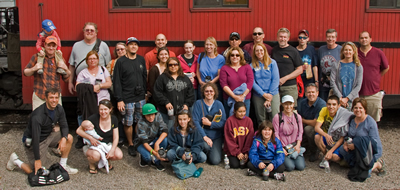News Archive
May 2018
Measuring the Particle Size Distribution and Concentration of Martian Dust (NASA)
In-Situ Resource Utilization (ISRU) involves collecting and converting local resources into products that can be used to reduce mission mass, cost, and/or risk of human exploration. NASA needs a dust sensor to measure 0.1 to 5 micron sized dust particles in the Mars atmosphere for future missions that will use ISRU techniques. Southwest Sciences will demonstrate an optical particle measurement technology that is based on a variant of laser intensity attenuation. The method is compact, low power, can be multiplexed to increase throughput and/or dynamic range, uses no consumable, and is independent of carrier gas, gas temperature and gas pressure. (Contact: Alan Stanton)
Measuring Radio Wave Amplitudes
Radio frequency communications and sensors are everywhere in both personal and military life. RF fields are also used in some medical therapies. However, little is known about the medical effects that result from the routine exposure of tissue to RF fields. To understand such effects, new instrumentation is needed that can quantify the RF radiation amplitude with spatial resolution comparable to the size of biological structures such as cells. Southwest Sciences is partnering with UC Berkeley to investigate a method of quantifying the amplitude of radio frequency fields in biological samples. Our approach is based on measuring resonance signals from nitrogen-vacancy-doped diamonds. The design uses only materials that are electrically and biologically inert, and the mass of the material is kept small. Initially the research will show the range of fields over which quantitative results can be obtained. (Contact: Chris Hovde)
Fiber temperature sensor
Superconducting magnets are used to manipulate particles in high energy physics. The windings of superconducting magnets must be monitored to ensure that temperature does not rise above the superconducting transition. Such a “quenching” accident caused $10M damage and shut down the large hadron collider at CERN for a year. A method for monitoring temperature that is immune to electrical noise is needed. Nitrogen vacancy (NV) or silicon vacancy (SiV) diamonds offer a way to monitor temperature optically. Southwest Sciences will partner with UC Berkeley to investigate spectroscopic techniques for measuring the sublevel population in both NV and SiV to determine temperature. Our vision is a fiberized design that allows the probe to be integrated with superconducting coils. (Contact: Chris Hovde)
Miniature Magnetometer for Europa
Missions to Europa will seek to confirm that moon’s underground sea by measuring Europa’s effect on Jupiter’s magnetic field. Meeting this science goal requires a very stable magnetometer. The helium vector-scalar magnetometer is a mature technology for this requirement, but recent work has shown that alkali vapor magnetometers can provide the needed stability with better SWAP. Southwest Sciences is investigating a magnetometer is based on atomic alignment, which has high sensitivity and inherently less heading error. Also proposed is a way to operate the magnetometer that allows it to provide both vector and scalar information. We will also test the radiation hardness of the vapor cell and polarization optics. (Contact: Chris Hovde)
April 2018
Compact CO2 measurement system (NASA)
Over the past decade, the importance of understanding the sources and sinks of carbon dioxide and other greenhouse gases has been recognized. Flux measurements of CO2 in the boundary layer help determine the carbon budget for this important greenhouse gas. The World Meteorological Organization has met its goal of 0.1 ppm CO2 accuracy for land based field sensors with gas chromatography and nondispersive infrared instruments. This project directly addresses the need for instruments that feature both high accuracy and a compact form factor for making measurements from unmanned aircraft or balloons.
To address this instrumentation need, Southwest Sciences has developed a compact (< 1 L), low power (< 2 watts), light weight (<1kg) diode laser based instrument to measure dry air corrected CO2 concentrations with a drift accuracy of <1 ppm at >1 hr and short term precision of 0.2 ppm at 1 second under static conditions. Over a 300 torr pressure range, 12°C temperature range, and 1.6% water addition, the system successfully measured within a standard deviationof 0.7, 0.8 and 0.4 ppm respectively of the actual concentration. (Contact: Alan Stanton)
July 2017
Wind Tunnel Characterization
Advances in computational capabilities for modeling the performance of advanced flight vehicles depend on verification measurements made in ground-based wind tunnels. As part of this process, the wind tunnels themselves must be well-calibrated and characterized. In particular to this project, the density, pressure and multi-component velocity of the air flow are of key interest. Southwest Sciences, in collaboration with the Southwest Research Institute, proposes to develop a novel, non-intrusive, laser-based measurement system for characterizing and calibrating the flow conditions upstream and downstream of test articles in wind tunnels. It uses inexpensive visible diode lasers and could be configured to match the needs of any particular type of wind tunnel, ranging from subsonic to hypersonic. The Phase I research will concentrate on developing and demonstrating the basic methodology of the system over a modest range of conditions. In Phase II we would expand the operation to the full range of expected conditions and verify the performance of the system in NASA-provided wind tunnels. (contact: Joel Silver).
July 2016
Detecting contaminants at fuel cell filling stations
Low concentrations of contaminants in hydrogen fuel can foul or damage fuel cells in hydrogen fuel cell vehicles, yet there is little monitoring of hydrogen quality at filling stations due to lack of suitable instrumentation. Southwest Sciences is developing a portable diode laser sensor. We have already demonstrated fast measurement of carbon monoxide, carbon dioxide, and methane in hydrogen, and we are working to expand the suite of measurements to include ammonia, hydrogen sulfide, water vapor, hydrogen chloride, formaldehyde, and formic acid. (Contact: Mark Paige).
Fast response nitrogen sensor for atmospheric science
Recent research has suggested that the commonly used assumption of dry air having no net flux is erroneous and can lead to significant errors in reported observations for eddy correlation flux measurements (Gu, L.; Massman, W. J.; Leuning, R.; Pallardy, S. G.; Meyers, T. P.; Hanson, P. J.; Riggs, J. S.; Hosman, K. P.; Yang, B., The fundamental equation of eddy covariance and its application in flux measurements. Agriculture and Forest Meteorology 2012, 152, 135-148). By directly measuring the density of nitrogen, the accuracy of flux measurements can be improved greatly (Gu, L., An eddy covariance theory of using O2 to CO2 exchange ratio to constrain measurements of net ecosystem exchange of any gas species. Agricultural and Forest Meteorology 2013, 176, 104-110). Southwest Sciences, Inc. is developing a portable analyzer to be used in conjunction with sonic anemometers to improve the performance of eddy covariance flux measurements. This instrument uses a new optical method to detect ambient nitrogen gas density with good precision and fast time response. Proof-of-concept research demonstrated that required performance specifications could be achieved. A prototype instrument under development will be constructed, characterized and tested in the field.(contact: Joel Silver)
July 2014
Monitoring from aerial platforms
NASA recently awarded three SBIR Phase I contracts to Southwest Sciences for the development of tunable diode laser gas spectrometers suitable for use on aerial platforms. Two of these projects are in support of NASA's atmospheric science programs, while the third is for planetary exploration. The first targets high accuracy measurements of CO2 using unmanned aerial vehicles (UAVs) which will bridge the gap between current land based and satellite platforms (Contact: Alan Stanton). In the second project, an inexpensive UAV-deployable methane sensor will be developed that will allow more economical measurements of methane in remote areas (Contact: Mark Paige). Southwest Sciences will develop small, lightweight, low power instrumentation for the in situ balloon-borne measurement of several trace gases of importance in the atmosphere of Venus, including carbon monoxide, water vapor, hydrogen fluoride, and carbonyl sulfide. (Contact: Alan Stanton)
Farm gases
Hydrogen sulfide (H2S) and methane (CH4) are two of the major pollutants associated with animal waste and sewage, and these gases can significantly affect air quality and human health. Southwest Sciences has been selected by the USDA to develop a compact, inexpensive optical sensor for H2S) and CH4 with high sensitivity and rapid time response suited for field monitoring of animal manure systems (contact: Joel Silver,).
Nitrous oxide
Nitrous oxide is the third most important greenhouse gas (GHG,) with an atmospheric lifetime of ~114 years and a global warming impact ~300 times greater than that of CO2. An accurate assessment of N2O emissions from agriculture is vital not only for understanding the global N2O balance and its impact on climate and also for designing crop systems with lower GHG emissions. Under a recently awarded DOE SBIR Fast Track grant, Southwest Sciences and Princeton University are developing new open-path eddy covariance techniques and instrumentation for continuous and fast (10 Hz) measurement of nitrous oxide emissions. (Contact: Alan Stanton; results are in this report)
Light filaments
Southwest Sciences and the University of New Mexico are partnering to investigate the use of light filaments for the detection of uranium compounds. Light filaments are formed by nonlinear interactions between high intensity, short pulse laser beams and air and allow propagation of nondivergent beams over significant distances. Such beams can be used for remote sensing via emission spectroscopy. This work is funded by the DOE/NNSA STTR program. (Contact: Kris Peterson)
Diamonds as sensors
DOE is funding an experiment to measure the electric dipole moment of neutron. This sophisticated experiment tests the standard model of particle physics by monitoring the response of neutrons in crossed electric and magnetic fields. Southwest Sciences has teamed with physicists at the University of Illinois to develop a method for measuring the strength of these electric and magnetic fields within the interaction region. It is a challenging environment, because access to the interaction region is limited, the temperature approaches absolute zero, and the sensors must cause minimal perturbations to the fields. The research will investigate a fiberized, all-optical sensor based on nitrogen-doped diamonds. (Contact: Chris Hovde; results are published here.)
March 2013
Groundwater Analyzer
DOE has selected Southwest Sciences to develop an analyzer to measure pollutants in groundwater. The analyzer is based on a novel cavity-enhanced spectroscopy. The development and testing program includes field tests and comparison to existing analytical techniques. The analyzer will initially target Cr(VI) ions. Contact: Chris Hovde
February 2013
Climate Science
Measuring the growth and structure of fine roots is important to understanding carbon uptake by plants, biogeochemical cycling and crop productivity. Southwest Sciences is developing a fast, high-resolution 3-dimensional optical tomography method for imaging plant roots in-situ. Contact: Kris Peterson
Methane is an important greenhouse gas released to the atmosphere during fossil fuel extraction and processing. Development of a diode laser-based analyzer that can be flown on an unmanned aerial vehicle (UAV) will facilitate wide-spread and accurate measurement of atmospheric methane concentrations. Contact: Mark Paige
Development of an instrument for fast, high precision carbon dioxide isotope ratio measurements on a UAV platform will aid researchers in identifying sources and sinks of atmospheric carbon dioxide for climate studies. Contact: Alan Stanton
January 2013
Breath diagnostics
SWS and Avisa Pharma have recently signed a license agreement for development of diode laser-based instruments for the detection of lung infections.
Office Manager Retires
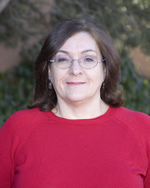
Southwest Sciences employees had a chance to thank long-time office manager Vickie LeDoux for her many years of service. Vickie joined the company when there were just three other employees. As the business grew, so did her responsibilities, which she met with characteristic efficiency, and she still had time for a glass of wine before volleyball games. In a related personnel move, Debbi Brody has been promoted to Office Operations Manager in recognition of the additional responsibilities she has taken on.
December 2012
Southwest Sciences selected as "Best Place to Work"

Southwest Sciences was one of New Mexico Business Weekly's Best Places to Work. The award is sponsored by Albuquerque Business First and honors New Mexico companies which are rated highly by their employees (as determined by surveys conducted by the business journal) as good places to work. Southwest Sciences was a winner for 2012 in the small business category.
November 2012
Fire Sensing on the International Space Station
NASA has selected Southwest Sciences to develop a replacement combustion products monitor for the International Space Station. A laser-based analyzer in a rugged, hand-held package will detect multiple gases that are indicative of smoldering or burning for enhanced crew safety. This technology is also applicable to earth-based needs for fire sensing, stack emissions monitoring, and air quality measurements. For more information contact Dr. Joel Silver
Magnetic Microscopy
DARPA funds proof-of-concept research to show how doped diamonds can be used to measure magnetic fields with high spatial resolution. Nitrogen-vacancy centers in diamond act as local magnetic probes. We are collaborating with Berkeley (Prof. Dimitry Budker) and TAMU (Prof Phil Hemmer). Contact: Chris Hovde
September 2011
Air Velocity Monitor
The Air Force awarded a Phase I STTR contract to Southwest Sciences to investigate a method for measuring air velocity around hypersonic flight vehicles. The research project partners the company with Professor Dick Miles of Princeton. PI: Chris Hovde.
August 2011
Southwest Sciences celebrates 25 years
Since its founding in 1985 by Alan Stanton and Joel Silver, the company has grown to address numerous research areas in atmospheric science, combustion and fire detection, non-destructive evaluation, measurement of magnetic and electric fields, and process monitoring and industrial hygiene. Three companies manufacture products based on technology developed at Southwest Sciences.
The Southwest Sciences families celebrated in Northern New Mexico style with a ride on the Cumbres and Toltec Scenic Railroad.
July 2011
Tropospheric carbon monoxide analyzer
Southwest Sciences has received a NASA SBIR Phase II contract to develop and test a field instrument for high sensitivity measurements of carbon monoxide in the troposphere.
Balloon-borne methane sensor
The Department of Energy has awarded a Phase II SBIR grant to Southwest Sciences for continued development of a self-calibrating sensor for balloon-borne measurements of atmospheric methane. (July 2011)
January 2011
Inlet Unstart Detector
A Phase I contract was awarded by the Air Force to develop an inlet unstart detector for hypersonic flight vehicles.
Imaging Sensor
Southwest Sciences received a Phase 1 grant from the NSF SBIR program to develop an imaging sensor system for chemical species concentrations and gas flow properties.
September 2010
Eli Rosen joins Southwest Sciences
Southwest Sciences welcomes Eli Rosen to our research team. Dr. Rosen arrives from a post-doctoral position at the University of North Carolina, where he investigated the chemical aging of organic aerosol particles. He also received his Ph. D. at UNC.
DOE awards grant for nondestructive evaluation
Southwest Sciences has been awarded a $1 million SBIR Phase II grant to develop an optical nondestructive inspection method for thermal barrier coatings (TBCs), which protect sensitive power generation and aircraft turbine components from the hot combustion gases. This advanced inspection method targets evaluation of TBC integrity/degradation and prediction of remaining useful life of the components.(PI: Kristen Peterson)
July 2010
Tony Gomez joins Southwest Sciences
We are pleased to announce that Tony Gomez has joined Southwest Sciences as a Senior Research Scientist. Dr. Gomez comes to SWS from a postdoctoral position at Sandia National Laboratory, Livermore. He received his Ph.D. in Physical Chemistry from UC Irvine in 2007.
July 2010
R&D 100 Award
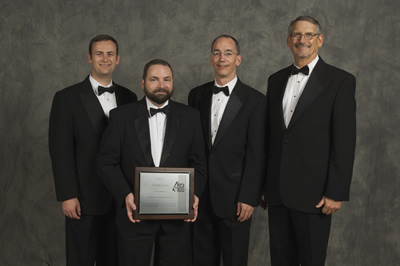
LI-COR Biosciences and Southwest Sciences have been awarded a 2010 R&D 100 Award for joint development of the LI-7700 Open Path Methane Monitor.
July 2010
Three SBIR Phase 1 grants were awarded to Southwest Sciences by the Department of Energy
Self-Calibrating Balloon-Borne Methane Gas Sensor for a low cost, low power diode laser instrument for high precision methane concentration measurements aboard balloon sondes for climate change studies will be developed in this project.
Instrumentation for Measurement of Atmospheric Nitric Acid for a new optical sensor platform that will provide a significant advance in the development of rugged, portable instrumentation for airborne measurement of nitric acid or other gases important in climate change.
Robust Spectrometer for Carbon Isotope Ratio Measurements for an instrument capable of providing in situ, accurate quantification of both carbon dioxide concentration and carbon isotope ratio of carbon dioxide. The goal is to provide real-time monitoring of carbon dioxide sources and sinks in the biosphere and atmosphere.
January 2010
The NIH has awarded Southwest Sciences an SBIR Phase I grant for time-resolved measurements of breath hydrogen sulfide
Hydrogen sulfide in breath can be an important indicator of gastrointestinal illness including colitis, irritable bowel syndrome, and Crohn’s disease. This project focuses on the development of a rapid, optical method for measuring hydrogen sulfide concentrations in individual exhaled breaths.
January 2010
NASA awards two Phase I SBIR projects to Southwest Sciences
NASA awarded two SBIR Phase I contracts to Southwest Sciences. The first project will show the feasibility of using gas filter correlation (GFC) spectroscopy using non-periodic gratings for spaceborne and airborne deployment. This innovative technical approach will result in smaller, lighter weight, lower power, and more rugged instrumentation than is possible using established GFC spectrometers. The approach is based on the development of non-periodic diffraction gratings that replace the reference gas cells used in GFC spectrometers. Steve Massick will lead the investigation.
The second project targets the development of a rugged, compact, and low power instrument for high sensitivity measurement of tropospheric carbon monoxide (CO). Phase I efforts will address the feasibility of measuring CO to a precision of 10 parts-per-billion or better over a range of tropospheric temperatures, pressures, and humidity. Successful development through Phase II should allow NASA to adopt a single high-reliability system for measurement of CO using a wide variety of platforms (e.g. aircraft, balloons, ground-based network, etc.).
Oct 2009
NASA Funds development of new instrument to measure greenhouse gases
Understanding the sources and sinks of carbon dioxide and other greenhouse gases has been recognized as critical to predicting climate change and global warming. In this SBIR program, Southwest Sciences is developing a lightweight, inexpensive greenhouse gas sensor. A novel measurement technique will allow the sensor to provide dry air mixing ratios of CO2 without the need for concurrent measurements of temperature, pressure or moisture. The sensor will be used on UAV, balloon, and aircraft platforms. Measurements of the precise variations of carbon dioxide as a function of altitude have been tremendously difficult, and this sensor will allow more widespread measurements than currently possible. Joel Silver is the Principal Investigator.
September 2009
Southwest Sciences works with UC Berkeley to develop magnetometer for physics experiment
Southwest Sciences will lead a project to develop a magnetometer for the neutron electric dipole moment (nEDM) experiment. The nEDM experiment uses crossed magnetic and electric fields to measure a possible electric dipole associated with the neutron, testing fundamental theories of matter. To achieve high sensitivity, the experiment needs very precise and homogeneous magnetic fields. Southwest Sciences is teaming with the Budker group at Berkeley to develop an instrument based on nonlinear magneto-optical resonance. The PI is Chris Hovde.
July 2009
DOE selects Southwest Sciences to investigate greenhouse gases and non-destructive testing
The Department of Energy has chosen Southwest Sciences to conduct two research and development projects. One project will develop a rugged laser source that can be used for making high-resolution measurements of carbon dioxide. The PI is Chris Hovde. The second project uses optical diagnostics to improve the ceramic thermal barrier coatings on advanced turbine. Kris Peterson is the project leader.
April 2009
Air Force awards three SBIR Phase I projects to Southwest Sciences
The Air Force has selected Southwest Sciences for three research and development projects.
- Southwest Sciences is developing optical coherence tomography (OCT) as a method to inspect for cracks or defects in silicon nitride ceramic bearing balls used in gas turbine aircraft engines. This approach is nondestructive, doesn't require fluorescent dyes, and can even detect defects below the surface. In this feasibility study, parameters important to OCT's application to defect detection in silicon nitride ceramics will be investigated, including optimal light wavelength, depth of penetration, resolution, and imaging speed. This project is led by Kris Peterson.
- The Air Force is experimenting with pulsed detonation engines. These engines use fast fuel injection and rapid mixing of fuel and oxidizer, giving them the potential to achieve higher efficiency and lower costs than scramjets or turbines. Optimizing these engines requires high-speed (~10 kHz) measurements of combustion species concentrations and distributions. Optical, non-contacting diagnostics are prefered because they don't change the combustion process or flow field. Southwest Sciences is developing a novel optical diagnostic based on frequency modulation spectroscopy. For more information contact Alan Stanton.
- Scramjet engines are important for high-performance military applications. Optimizing the performance of a scramjet engine requires an accurate model of combustion and fluid dynamics. Southwest Sciences is assisting the Air Force in this effort by developing a specialized instrument that can detect species concentrations, temperatures and mass flow through the scramjet engine flowpath. The project uses our proprietary Lock-In Detector Array (LIDA) together with diode laser absorption spectroscopy, which will allow for a compact airbone instrument. Making quantitative measurements in-flight avoids the complications with interpreting wind tunnel tests. Contact Alan Stanton about this project.
January 2009
Optics for improving combustion research
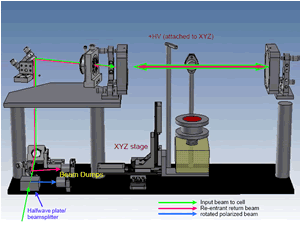 The green beam from a doubled Nd:YAG laser is used to excite Raman spectra
in a flame. To increase the signal, the laser beam is directed through a small
hole in one mirror into a nearly-concentric Herriott multipass cell. The beam
bounces over one hundred times between the mirrors, always passing within
a few millimeters of the center point. By moving the burner around this point,
the temperature of the flame can be mapped.
The green beam from a doubled Nd:YAG laser is used to excite Raman spectra
in a flame. To increase the signal, the laser beam is directed through a small
hole in one mirror into a nearly-concentric Herriott multipass cell. The beam
bounces over one hundred times between the mirrors, always passing within
a few millimeters of the center point. By moving the burner around this point,
the temperature of the flame can be mapped.The Air Force has selected Southwest Sciences for a Phase II STTR contract to continue development of optics to improve the signals from combustion measurements. Researchers at the Wright Laboratory use Raman spectroscopy to understand the effects electric fields have on flames. Raman spectroscopy can measure the temperatures of a flame without perturbing it. However, Raman spectroscopy is a weak effect, so signals are low. Increasing the laser power can increase the signal, but laser breakdown sets a limit on the improvement by this path. Dr. Joel Silver showed in a Phase I project that multipass optics can improve the ratio of signal to noise by at least a factor of 50. The optics create a tightly-knit pattern of laser beams at the center of a pair of mirrors. Each beam in the pattern contributes to the Raman signal. The system can also be used to enhance absorption signals in tunable diode laser spectroscopy measurements of species concentrations. The research team includes Dr. Philip Varghese of the University of Texas, who will compare temperature measurements taken with this system to more traditional Raman measurements. For more information, contact Joel Silver.
October 2008
Quantum Dot Lasers for improving LADAR systems
The Air Force has selected Southwest Sciences for a Phase II SBIR project to develop quantum dot lasers systems for military LADAR applications. This two-year project is led by Dr. Dan Kane.
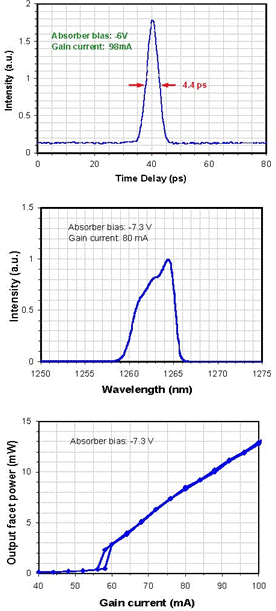 The typical pulse width, gain bandwidth, and L-I (light vs current) curve
of an 8 mm long, 2 section quantum dot mode-locked laser.
The typical pulse width, gain bandwidth, and L-I (light vs current) curve
of an 8 mm long, 2 section quantum dot mode-locked laser. Military LADAR systems are used to identify tanks and other objects, even in the presence of camouflage. LADAR systems use pulses of light to make a topographic map of the target. Light pulses of short duration can provide more details which leads to more reliable identification of the target. Real world military systems also must be compact, robust, and inexpensive. Southwest Sciences has teamed with Professor Luke Lester at the University of New Mexico in Albuquerque, NM to build and characterize monolithic, passively mode-locked quantum dot semiconductor lasers for LADAR applications. With pulse widths of less than 5 ps, they easily meet the time resolution and bandwidths needed for the shaping requirements of next generation military systems.
Quantum dot laser development requires simultaneous development of the lasers and laser characterization tools. Prof. Lester has pioneered quantum dot laser R&D, and his laboratory is well equipped for the development portion of the project. Dr. Daniel J. Kane at Southwest Sciences has pioneered methods for ultrashort laser pulse characterization. He is the co-inventor of the most effective characterization method: frequency resolved optical gating (FROG). The Phase II effort will build on methods developed in Phase I and will continue the development of quantum dot-based passively mode-locked diode lasers in order to better facilitate the use of these lasers in arbitrary optical waveform generation for LADAR applications.
October 2008
High Precision CO2 Field Sensor
Southwest Sciences has won a grant to develop instrumentation for detecting carbon dioxide (CO2), the Department of Energy announced. The two-year grant through the SBIR program funds additional research and development of this new instrument, which will be useful in studying how CO2 is taken up by the biosphere. Such research is a vital part of the Global Climate Change Initiative (GCCI), which calls for a better scientific understanding of the sources and sinks of CO2 and of the interactions between the biosphere and atmosphere. The research is led by Dr. Joel Silver, a co-founder andVice-President of Southwest Sciences.
"While a variety of instruments exist for high precision flux measurement of CO2 and other greenhouse gases, none combine the attributes of reliability, precision and low cost," says Dr. Silver. His approach combines traditional optical spectroscopy with an automated method for calibrating the instrument. This project builds on the successful Phase I research, which demonstrated that the self-calibration procedure can achieve high precision (needed for the science goals) without external calibration gases or expensive temperature control of the instrument. The Phase II research addresses issues beyond laboratory performance, such as the ability to be deployed in widespread field operations over extended periods of time, as will be needed to study long-term variations in CO2 exchange between the biosphere and the atmosphere. For more information, contact Joel Silver.
September 2008
Residential Fire Detection
The United States ranks poorly among industrialized nations in fire safety.
Various statistics from the US Fire Administration illustrate our national
problem. Fire killed more Americans in 2006 than all natural disasters combined.
Fire-related injuries have declined over the last decade; yet fatalities remain
nearly constant. Functioning smoke detectors are present in 23% of fatal residential
structure fires. These facts imply a need for better home fire sensors. Digging
more deeply, however, reveals additional issues. Fire fatalities occur disproportionately
among young children and the elderly, and – as with fatal automobile
accidents – alcohol consumption is involved in nearly half of fatal fires.
Also, poverty and fire are statistically linked. The death rate in poorer
sections of the country is three times the national average.
Dr. Steve Massick is leading a research project funded by NIST to develop a new generation of smoke detectors to improve safety in the home. "Existing smoke detectors are not very effective, particularly for children and the elderly," he says. New fire sensing technology must be cheap, (nearly) maintenance free, and provide fast response to kitchen fires as well as fires originating in clothing, furniture, and bedding. These types of fires are problematic for conventional photoelectric and ionization smoke detectors, so fire detectors are not placed in kitchens. Southwest Sciences approach is based on a combination of low cost optical imaging sensors to provide immunity from false alarms, so that kitchen fires can be detected and alarm thresholds can be reduced to provide earlier warning of fires. Low costs per sensor will enable a network of these devices throughout the residence. This is a difficult problem, but the benefits can be measured in thousands of lives and hundreds of millions of dollars saved every year.
May 2008
Southwest Sciences wins two DOE awards
The US Department of Energy awarded Southwest Sciences two Phase I SBIR grants. The first is "Differential Absorbance Spectrometer for Carbon Dioxide Isotope Measurement." This project seeks to develop a compact, rugged, low cost optical sensor platform for measuring isotopic ratios of carbon dioxide and other important greenhouse gases. Such a sensor would help research to understand the effects of carbon dioxide on climate. The second project, "Magnetometer for the Neutron Electric Dipole Moment Experiment," will develop technology to measure magnetic fields with high sensitivity. This capability will benefit DOE’s fundamental research, but also has spin-off applications in medicine, mineral exploration, and homeland security.
April 2008
USDA award for measuring hazardous gases at animal farms
Significant emissions of environmentally important gases result from manure management systems associated with animal production. Confined livestock and poultry operations are identified as important sources of emissions that are of environmental concern on spatial scales ranging from local to regional, national, and global. Hydrogen sulfide is one such gas. Existing detection methods for measurement of H2S are slow and possibly susceptible to false results due to other sulfur compounds. The proposed approach will directly measure H2S emitted from animal production operations, particularly manure management systems. This project will demonstrate an instrument that can provide a versatile combination of high sensitivity and fast time response that will greatly enhance capabilities for measuring concentrations and emission rates of H2S associated with animal manure management systems.
January 2008
Senator Bingaman visits Southwest Sciences
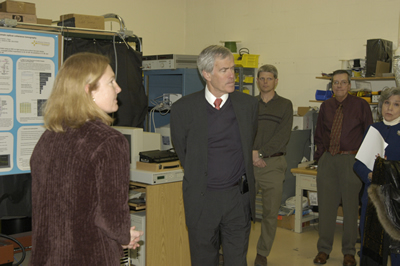
Senator Bingaman visits Southwest Sciences.
Senator Jeff Bingaman toured Southwest Sciences' facilities where he learned about ongoing research into new medical imaging, trace gas detection and optical diagnostics. He discussed the importance to New Mexico's economy of small businesses like Southwest Sciences which create high-value products based on new technology, and the role the Federal government can play in advancing these opportunities.
November 2007
NASA awards four Phase I SBIR contracts to Southwest Sciences
NASA selected four proposals from Southwest Sciences for award in the highly competitive SBIR program. The projects span the range of Southwest Science's research efforts. "Optical Method for Real-Time Turbine Blade Tip Clearance Measurement" uses an innovative technology based on optical Fourier domain reflectometry for near real-time tip-clearance measurement with an accuracy of 10 micrometers or better. Benefits of this approach include increased turbine efficiency, reduced emissions, and extended service life. "Magnetometer for Calibrating Jovian Fields" investigates a method to accurately measure total magnetic fields in the range 0 to 1.6 mT in support of missions to Jupiter. "Fast Temperature Sensor for use in Atmospheric Sciences" investigates a low power approach to measure temperature that is unaffected by cloud particles or aircraft speed. The sensor will be sufficiently lightweight and compact for use on balloons, kites, and UAVs as well as more conventional research aircraft. "Mirage Fire Sensor for Spacecraft" will use highly miniaturized, low power cameras to image a simple geometric pattern projected onto a flat surface, detecting fires by the distortion of the image.
October 2007
Southwest Sciences wins R&D 100 Award
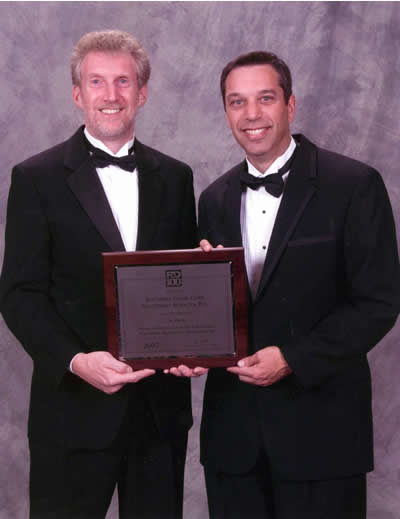
Joel Silver and Mark Paige receive the R&D 100 Award.
Southwest Sciences teamed with Southern Cross to develop the '46 Hawk, a hand-held detector for finding leaks in the natural gas pipeline network. Southwest Sciences gas detection technology eliminates hazmat problems with earlier detectors and shows excellent sensitivity and selectivity, with virtually no false alarms. This invention received the R&D100 Award, and it is now manufactured and sold by Southern Cross.
May 2007
Southwest Sciences partners with Southern Cross for gas leak detection
Southwest Sciences has joined with Southern Cross Corporation to develop instruments for natural gas leak detection. Southern Cross of Norcross, GA is the premier gas leak detection workforce service provider and manufacturer of electronic leak detection equipment in the United States. The first product developed under this partnership is the '46 Hawk handheld leak sensor. The Hawk uses diode laser spectroscopy to detect methane. A wide dynamic range was achieved so that the Hawk is capable of measuring trace concentrations of less than 1 ppm for locating leaks, all the way to 100% methane for finding the source of the leak.Contact Information
e-mail info@swsciences.com

